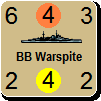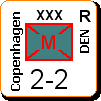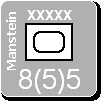warspite1
Posts: 41353
Joined: 2/2/2008
From: England
Status: offline

|
If he`s still looking in on this forum, Hellfirejet this one is for you!
Please see Scharnhorst below featuring operations Juno and the battle of North Cape
[4771 Scharnhorst - by Robert Jenkins]
.B Engine(s) output: 165,000 hp
.B Top Speed: 32 knots
.B Main armament: 9 x 11-inch (280mm), 12 x 5.9-inch (150mm) guns
.B Displacement (full load): 38,900 tons
.B Thickest armour: 13.75-inch (belt)
.P The two-ship Scharnhorst-class are sometimes classified as battlecruisers
and sometimes battleships; certainly the German Navy classified them as the
latter. However, they were the opposite of what a battlecruiser was traditionally
designed to be; lightly armoured but powerfully armed, and were in fact lightly
armed and heavily armoured. They are referred to as battlecruisers in these write
-ups. They were built for the Kriegsmarine between 1935 and 1939.
.P The Gneisenau and her sister Scharnhorst were originally intended to be better
armoured versions of the Deutschland-class pocket-battleships. However, to avoid
the ships becoming un-balanced (too heavy armour protection for too little
hitting power) a third 11-inch turret was added to their design. As such, the
revised specification of these ships made them less like pocket-battleships and
more like battlecruisers.
.P Then, after the signing of the Anglo-German Naval Agreement in June 1935,
Adolf Hitler wanted to increase the main armament to a 15-inch (381mm) gun in
order that the battlecruisers main armament would compare with that of British
capital ships. This would mean their introduction would be delayed by up to two
years and this was not something Hitler could afford to do, given his territorial
ambitions.
.P The two ships were therefore completed with the smaller gun with a plan to
upgrade their main armament at the first opportunity. As it turned out, the
upgrade never happened and the two ships remained with their original main
armament throughout their life.
.P Both ships were named after important Prussian military figures from the
Napoleonic war era.
.P Scharnhorst`s first operation of the war began at the end of November when the
Kriegsmarine tried to get both her and her sister into the Atlantic. They sailed
initially with the cruisers KÖln and Leipzig and accompanying destroyers,
but then left them on the 22nd to proceed together toward the Faroes-Iceland gap.
The British armed merchant cruiser Rawalpindi was on patrol there and on the 23rd
the battlecruisers came across the British vessel. Scharnhorst, the lead vessel
was the first to see Rawalpindi and her captain, Hoffman, ordered the British
vessel to identify herself. However, his opposite number, Captain Kennedy simply
acknowledged the German signal and sought to shake off the battlecruisers. The
speed differential made this impossible and so Kennedy gave the order to open
fire. Despite being hopelessly outgunned the British captain chose to fight
rather than surrender. It was no contest. The profile of the Rawalpindi, with her
high sides and tall superstructure was an ideal target and the Scharnhorst, and
later the Gneisenau pounded her into submission. At one stage a shell struck the
bridge, killing Kennedy and everyone else in the vicinity. The fight was all over
within forty minutes and when flames reached one of her magazines, Rawalpindi
blew up. As a result of the action and the fact that the British would be aware
of his intentions, Vice-Admiral Marschall called off the sortie and the two
battlecruisers returned to Germany without problem, despite a massive search
by the Home Fleet.
.P Her next operation, Operation Nordmark, came in February (see Admiral Hipper).
Nordmark was an uneventful operation that lasted just three days. Her next
mission was a different proposition altogether. In company with Gneisenau,
Scharnhorst took part in the audacious combined operation to conquer Norway;
Operation Weserübung (see Gneisenau).
.P Weserübung was a success, although it did cost the Kriegsmarine a number of
irreplaceable warships. The British and French response had been badly thought
out and executed and within a short space of time they were clinging on to their
only foothold in Norway; around the northern port of Narvik. The overseas supply
line to this remote region was long and more importantly, the Germans had control
of the rest of Norway, giving the Luftwaffe control of the skies. The Allies had
no choice but to evacuate Norway and this process began at the beginning of June.
.P The Kriegsmarine decided to attack the lengthy Allied supply route and
earmarked Scharnhorst, Geneisenau, the heavy cruiser Admiral Hipper and four
destroyers for the purpose. The force was commanded by Marschall on board
Gneisenau; the operation was code-named Juno. On the morning of the 4th June
1940, these ships sailed from Germany.
.P On the 8th June, the German ships came across came across a trawler, Juniper,
that was escorting the tanker Oil Pioneer back to the UK. These two ships were
quickly sunk by Hipper and the destroyers. A little later, they came across the
hospital ship Atlantis and the empty troopship Orama which were also returning to
the UK separately to the main evacuation convoys. Sparing the hospital ship, the
Orama was sunk with the loss of 19 crewmen. Hipper and the destroyers were then
detached and returned to Trondheim, while the battlecruisers continued their
mission.
.P Later that day at about 1600hrs, the battlecruisers were sighted by the Royal
Navy aircraft carrier Glorious. She too was separate from the main convoy for
reasons shrouded in mystery. She was escorted by the destroyers Ardent and
Acasta. For unknown reasons, the carrier was flying no combat air patrol and
indeed there were no aircraft ready on deck to take-off quickly. For these errors
over 1,500 sailors and airmen would pay the ultimate price.
.P Glorious sent Ardent to try and identify the ships in the distance and, as a
precaution, five Swordfish were to be readied for take-off. However, no aircraft
had time to get on deck and launch before Glorious` ability to launch had
disappeared. When the German ships spotted the British force they made full speed
for their target. Gneisenau opened the firing against Ardent at 1627 hrs and
Scharnhorst opened the firing against Glorious at 1632hrs. Ardent withdrew after
launching an unsuccessful torpedo strike at Scharnhorst and both destroyers made
smoke to try and screen the carrier. But by then Glorious had already been hit at
least twice, the first causing a fire in the upper hangar and the second smashing
into the bridge, killing the captain. For a time the destroyers became the main
targets and Ardent was the first to succumb at 1725 hrs. Five minutes later
Acasta fired a salvo of torpedoes at Scharnhorst, scoring a hit with one of them
that killed 48 German sailors. However, she too was then subjected to intense
gunfire and was soon ablaze. She sank at 1820 hrs. With the smokescreen now
clearing, Glorious became the target once more. She was hit in the main engine
room and immediately began to lose speed. She also developed a list and her
position became hopeless. Glorious sank at 1810 hrs. With Scharnhorst damaged,
Marschall ordered his ships to depart the scene immediately and return to Norway.
They were back in Trondheim around midday on the 9th.
.P In response, the Royal Navy tried to launch an air attack against Scharnhorst
launched from the aircraft carrier Ark Royal on the 13th. However, the attack by
fifteen Skua aircraft was a failure as only one hit was recorded; and that simply
bounced off her armour plate. Scharnhorst sailed for Germany on the 21st and
having survived another air attack on route, reached Kiel two days later.
.P Scharnhorst`s next mission, Operation Berlin, was a break-out into the North
Atlantic, and for this she was once again in company with Gneisenau (see
Gneisenau). The two ships arrived in Brest on March 22nd, but Scharnhorst needed
urgent repair work before she would be fit for action again. She was almost
repaired and ready for duty in July 1941, when she was hit by five bombs while
under-going trials at La Pallice.
.P It was clear that the ports of western France were no longer safe for the
Kriegsmarine`s heavy units. In addition, Adolf Hitler wanted his heavy units back
in Germany, and so came up with a plan to bring Scharnhorst, Gneisenau and the
heavy cruiser Prinz Eugen home from Brest through the English Channel. Operation
Cerberus was a most audacious plan and one that caught the British napping (see
Prinz Eugen). Although Scharnhorst was mined twice during Cerberus, she got back
to Germany on the morning of the 13th February.
.P Repairs to the damage received during the "Channel Dash" took until October to
complete, following which she undertook a work-up exercise in the Baltic
alongside the cruisers Leipzig and Nürnberg. She was then ready to attempt the
journey to Norway, where she was required to join the battleship Tirpitz, in the
New Year.
.P In January 1943 she sailed for Norway with the heavy cruiser Prinz Eugen and
three destroyers for escort. She was thwarted in the attempt though as the Royal
Air Force (RAF) spotted the German ships and forced their return to Germany. Two
weeks later, on the 23rd, the Germans again tried to get the two ships to Norway,
but once again the RAF were able to sight the ships and their recall was ordered.
It was only at the third attempt, in March, that Scharnhorst was able to reach
Norway. She sailed with a destroyer and torpedo boat escort and arrived in Narvik
in the north of Norway on the 9th. Once there, she took part in exercises with
Tirpitz and the cruiser Lützow, the latter having arrived in Norway shortly after
Scharnhorst, in preparation for forthcoming operations.
.P In September, Scharnhorst took part in Operation Sizilien alongside Tirpitz
and a nine-strong destroyer escort under the command of Admiral Kummetz. This
operation was designed to attack enemy installations on Spitzbergen in the Arctic
Circle (see Tirpitz). Following this operation, Scharnhorst remained in the north
of Norway until December, when she sailed for her final operation.
.P The heavy units of the Kriegsmarine had made little impression on the Arctic
convoy traffic between the United Kingdom and the Soviet Union. Most of the
losses that had been incurred by the Allies had been caused by the Luftwaffe or
the U-boat service. Just before Christmas 1943, Admiral Dönitz ordered an attack,
code-named Ostfront, by his sole remaining serviceable capital ship, Scharnhorst.
For the operation, Scharnhorst, commanded by Rear-Admiral Bey, could call upon
the destroyers of the 4th Destroyer Flotilla as escort.
.P The convoys at sea at the time Scharnhorst sailed were the Soviet bound JW55B
that had left the United Kingdom on the 20th December and the homeward bound
RA55A that left Russia two days later. In addition to their usual close escort,
these convoys had the following escorts: Force 1, commanded by Rear-Admiral
Burnett, was a cruiser force that consisted of the heavy cruiser Norfolk and the
light cruisers Belfast and Sheffield and Force 2, commanded by Admiral Fraser,
and consisting of the battleship Duke of York and the light cruiser Jamaica.
Force 1 was heading west and it was planned that she would meet up with the east
bound convoy east of Bear Island. Force 2, the distant covering force, was
further to the west and heading east behind JW55B.
.P The west bound convoy had been sighted by German reconnaissance on Christmas
Day and Scharnhorst was given the green light for Ostfront to commence that
afternoon. The battlecruiser and her escorts sailed from their base in Altafjord
in the early evening, heading north. The British had picked up signal traffic and
were aware that Scharnhorst was at sea. Force 1 headed in a southwest direction
to intercept the Germans and Force 1 continued in her easterly direction.
.P At 0730hrs on the morning of the 26th, Bey ordered his destroyer force to
increase the search area by sailing to the southwest. Scharnhorst executed what
was essentially a wide 360 degree turn and was soon heading north once more. The
destroyers were never to see their Flagship again as they then lost contact. An
hour later, Norfolk`s radar picked up what proved to be Scharnhorst, which was,
at that time about 25,000 yards away.
.P Bey was unaware of two things at this point; firstly he was only about thirty
miles from JW55B and heading straight for the convoy. Secondly, he was still
unaware of both British forces, let alone the fact that the cruiser force was
closing the range to her all the time.
.P The battle commenced at around 0920hrs when Belfast opened fire with the range
at around 13,000 yards. Norfolk followed suit and Scharnhorst quickly responded.
However, it was Norfolk`s 8-inch guns that found their target first and
Scharnhorst was hit a number of times, one of these put her radar out of action.
Bey ordered his Flagship to turn away, although Burnett`s force was able to stay
in contact. In addition, the British ordered four destroyers from RA55A to join
Force 1. Bey, still unaware that there was a British battleship anywhere near,
now had a slice of good fortune when radar contact was lost. He ordered his
destroyers to join him, although this was never achieved and later, when Bey had
decided to head back to Norway, the same instruction was given to his destroyers.
.P At around midday, the British were able to make radar contact once more and
fire was resumed at 1220hrs. This time, Scharnhorst`s gunnery was more accurate
and she destroyed Norfolk`s radar and one of her main turrets. Sheffield was also
lightly damaged.
.P Bey turned south and unknown to him, put Scharnhorst on a collision course
with Force 2. The cruisers and destroyers of Burnett`s force continued to shadow
Scharnhorst. Duke of York picked up Scharnhorst at around 1615hrs. Half an hour
later Bey got a most rude awakening when Duke of York and Jamaica opened fire.
Scharnhorst responded whilst at the same time turning first east and then north
to try and open up the distance.
.P Although she had taken severe punishment, including putting her Anton and
later, her Bruno turrets out of action, she still had the advantage of superior
speed and at around 1800hrs the distance was increasing between Scharnhorst and
her tormentors. But escape was not to be. At around 1825hrs, a shell fired at
long range from Duke of York exploded in one of Scharnhorst`s boiler rooms. This
had the effect of reducing her speed and thus allowing the British ships to close
the range once more. The four destroyers were now close enough to launch
torpedoes and four of these struck Scharnhorst; her fate was now sealed.
.P At around 1915hrs, the last of Scharnhorst`s main turrets was put out of
action. Belfast and Jamaica were ordered to launch torpedoes, followed by the
remaining destroyers. The order was given to abandon ship soon afterwards and she
sank after a huge explosion at 1945hrs.
.P The British were able to pick up just 36 survivors from her crew of 1,968.
Admiral Fraser paid tribute to Rear-Admiral Bey and the way Scharnhorst had
fought to the end against an opponent far superior in numbers. Bey was not one of
the survivors.
_____________________________
England expects that every man will do his duty. Horatio Nelson October 1805  |
 Printable Version
Printable Version













 . I shall amend accordingly.
. I shall amend accordingly. 

 New Messages
New Messages No New Messages
No New Messages Hot Topic w/ New Messages
Hot Topic w/ New Messages Hot Topic w/o New Messages
Hot Topic w/o New Messages Locked w/ New Messages
Locked w/ New Messages Locked w/o New Messages
Locked w/o New Messages Post New Thread
Post New Thread